Kanji Ability Mastery of Japanese Literature Study Program’s Students, Faculty of Arts, Udayana University
on
Udayana Journal of Social Sciences and Humanities, Vol. 2 No. 1, February 2018 | 13
DOI: https://doi.org/10.24843/UJoSSH.2018.v01.i01.p03
Kanji Ability Mastery of Japanese Literature Study Program’s Students,Faculty of Arts, Udayana University
I Gede Oeinada
Japanese Literature Study Program Faculty of Arts, Udayana University Jalan Pulau Nias 13 Denpasar, Bali Indonesia gede.oeinada@unud.ac.id
AbstractsKanji ability of Japanese Department students, Faculty of Arts, Udayana University namely the third-year students and the second-year students is measured by a test on Kanji mastery (漢字力診断テストkanji-ryoku shindan tesuto). This test measures 12 aspects of Kanji mastery ranging from the mastery of meaning, word structure, form, writing, to how to read Kanji’s onyomi. The third-year students have stopped receiving Kanji lecture while the second-year students are still getting Kanji lecture. The test results indicate that there is a relevancy between Kanji lecture and the average ability increasing in Kanji mastery aspects of the students. The increasing on the scale value of the test results by the third-year students is only on 3 aspects i.e. only 25% of the total Kanji mastery aspects. Meanwhile, in the second-year students is as much as 7 aspects i.e. 58% of the total Kanji mastery aspects measured. The weak aspect of Kanji mastery that needed to be increased in both classes is the aspect of how to read the Kanji’s onyomi (音読み(同音・形声)on-yomi douon-keisei). This aspect can be trained by utilizing the communication and information technology (CIT) of Japanese language learning that has been available online namely the Kanji-en site. The Kanji-en site has Kanji exercises that emphasize the aspect of Kanji onyomi reading (音読みon-yomi)so that it is suitable to be used in improving the Kanji ability of Japanese Department students, Faculty of Arts, Udayana University. By using an interactive learning media that is available in this site, surely it can increase the motivation and spirit of Japanese language learners, especially in the field of Kanji mastery.
Key words: Kanji Ability Mastery Test, Utilization of communication and information technology (CIT), Japanese Literature Study Program, Udayana University
-
I. INTRODUCTION
The Japanese Literature Study Program, Faculty of Arts, Udayana University, which was officially established since 2006, has conducted undergraduate education (S-1) in Japanese language and literature. One of the learning materials in the Japanese Literature Study Program, Udayana University is learning Japanese letters through Hyouki Course. In Japan, the Japanese uses three types of letters, namely: Kana consisting of hiragana (46 letters) and katakana (46 letters), Kanji, and Latin letters (alphabet). The number of Kanji required by the Japanese government to be mastered by the its people is called 常用漢字Jouyou Kanji which has 2,136 letters (Sakade and Ikeda, 2013). Hyouki Course at Japanese Literature Study Program,
Udayana University is given since the students are in the first semester up until fourth semester. The textbook used is Basic Kanji volume 1 in semester 1, Basic Kanji volume 2 in semester 2, Intermediate book Kanji volume 1 in semester 3, and Kanji Intermediate volume volume 2 in semester 4. Basic Kanji books volume 1 and 2 contain about 500 basic Kanji letters. Together with the Kanji Intermediate volume book 1 and 2 which contains about 500 Kanji letters, the Kanji learning given and expected to be mastered after the students finish the 4th semester is around 1,000 Kanji.
In Kanji learning, there are two ways to read Kanji, namely: Kun-yomi (Japanese-style Kanji’s way of reading) and On-yomi (Chinese-styleKanji’s way of reading). Each of the Kanji's way of reading is not always one. Kanji 生 for example, has its way of reading as many as 21 ways,
namely 2 ways ofon-yomi: "shou" and "sei", and 19 ways of kun-yomi: "ha (eru)", "ha (yasu)", "i (kasu) "," Na (rasu) "," na (ru) "," na (su) "," o (u) "," shou (jiru) "," i (keru) "," i (keru) ", "Shou (zuru)", "u (mareru)", "u (mu)", "name", "i (ki)", "u (mare)", "u (mi)", "-fu "," Ki "(Nelson, 1999: 378). In addition, the Kanji letters consist of strokes that the number of those strokes for each Kanji must be remembered in order to write the Kanji correctly. The lowest number of Kanji strokes is one, the Kanji 一 ichi 'one'. While the highest number of Kanji strokes is 29 strokes, the Kanji 鬱 utsu 'depression; moody'(Sakade and Ikeda, 2013). Although a Japanese learner has mastered the required way of reading and writing those Kanji, their task does not stop there because the single-letter of a Kanji can be used together or called the combined Kanji (熟語 jukugo) which will mainly create a new way of reading and meaning. Therefore, given the many aspects of Kanji learning is important for Japanese language learners to know their level of Kanji Ability Mastery so that they can focus more on correcting their deficiencies and retaining the advantages they already have. If a learner does not know their current level of mastery over Kanji then surely the energy they devote or the effort they make in Kanji learning cannot produce optimal results.
Based on the description that has been described in the section above, then the problems studied in this study can be formulated as follows: 1) How is the level of Kanji Ability Mastery at the beginning of the semester of Japanese Literature Study Program’s students of Udayana University? 2) How is the level of Kanji Ability Mastery at the end of the semester of Japanese Literature Study Program’s students of Udayana University? 3) How is the effective Kanji learning strategy to overcome the lack of aspects of Kanji mastery that should be mastered by the students of Japanese Literature Study Program of Udayana University?
-
II. RESEARCH METHODOLOGY
The research method used in this study is descriptive method that is quantitative and qualitative. Descriptive method aims to create a description (description) in a systematic, factual, and accurate and also the nature and relationship of the phenomena studied (Djajasudarma, 1993). The 6th semester students of class 2014 who became the subject of this study are 37 students. Meanwhile, the 4th semester students of class 2015 who also became the subject of this study are 35 students.
There is a test that they must perform in order to know theirKanji Ability Mastery level. The test was held twice. First, in the second week of February 2017 and second, at the end of the semester of academic year 2016/2017. The raw data in the form of test results of those students are analyzed to know and compare their degree of mastery over Kanji. Model of the tests were taken from Kanji tests by
Kano (1993:1-15), namely: "Diagnostic Test of Kanji Ability (漢字力診断テストKanji ryoku shindan tesuto).
There are 11 (eleven) parts of the test that must be done by a Japanese learner who wants to know their Kanji mastery level. Each test section consists of 10 to 20 questions. The 11 tests measure 12 (twelve) aspects of Kanji's mastery, namely: 1) Mastery of meaning/meaning 2) Word structure/word structure 3) Shape/shape 4) Writing Kanji one letter / single word writing 5) Writing Kanji combined / phrase writing 6) Selection of Kanji based on context/choice from the context 7) Usage based on word class/part of speech usage 8) Usage based on the Kanji / conjugational ending usage 9) Reading based on context/reading from the context 10) a single letter Kanji reading / single word reading 11) Kanji reading combination/phrase reading 12) How to read on-yomi Kanji / ON-reading.
The test results are shown in the form of a circular graph with 12 angles as follows:
Mt
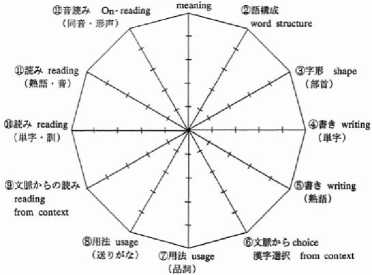
Through the Kanji Ability Mastery, the aspects of Kanji mastery that has been mastered well by the students and aspects of mastery Kanji that is still lacking can be clearly observed. In addition, the tests conducted twice at the beginning of the semester and at the end of the semester will show the comparison and development of the students Kanji ability after attending lectures in a semester. The findings of this research are then used as the basis for formulating effective Kanji learning strategies needed to overcome the aspect which needs improvement.
-
III. RESULTS AND DISCUSSION
In this section, there are two things that will be discussed, namely level of Kanji Ability Mastery of Japanese Literature Study Program of Udayana University and Kanji's Learning Strategy to Overcome The Disadvantages on How To Read Kanji On-yomi (@)
-
3.1 Level of Kanji Ability Mastery
The measurement results are shown in the form of a circular graph with 12 angles with each angle having a scale of 0 (lowest) to 5 (highest) values as follows:
a. Kanji Ability Mastery Average of Class 2015
07 February 2017
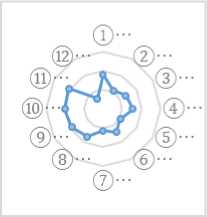
06 June 2017
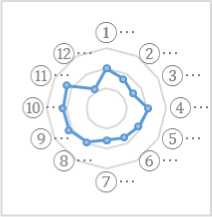
Graph 1. Kanji Ability Mastery Average of Class 2015
Graph 1. is a graph showing development in Kanji Ability Mastery average of class 2015 students. It can be seen that there are improvement in 7 aspects of kanji ability mastery, namely:Word Structure (@), Writing Kanji either One-letter Kanji (©) or combination (©), Usage by word class (@) or Kanji ending (®), Kanji reading combination / phrase reading (@), and also Kanji on-yomi ©).
The scale values can be described in each of the following aspects of kanji mastery:
cts
nnin
g
Deve 0 +1 0 +1 +2 0 +1 +1 0 0 +1+1
lopm ent
The highest score scale is 5. The Kanji Ability Mastery average of the class 2015 is on the scale of values 1 to 4. The Kanji mastery aspect whose value scale is still low at the beginning of the test but has shown improvement at the end of the test that is on the aspect how to read the Kanji onyomi (©), i.e. from the scale of value 1 to scale of value 2. In general, there is an increase in the scale value of the survey results in 7 (58%) aspects of Kanji mastery. Nevertheless, the Kanji-Kanji combined reading aspect in the form of phrase (熟語jukugo), or aspects of Kanji on-yomi reading method should be trained more so that the Kanji ability of Japanese Literature Study Program of Udayana University can be increased more.
b. Kanji Ability Mastery Average of Class 2014
06 February 2017
15 May 2017
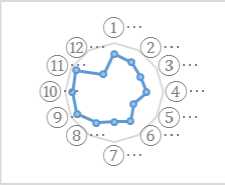
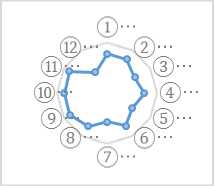
Graph 2. Kanji Ability Mastery Average of Class 2014
Graph 2. is a graph showing development in Kanji Ability Mastery average of class 2014 students. It can be seen that there is an improvement in 3 aspects of kanji ability mastery, namely: Writing Kanji either one letterKanji (©)or combination (©) and also Kanji Selection based on context (©).
The scale values can be described in each of the following aspects of kanji mastery:
|
Aspects |
© @ ® |
© |
© |
© |
© ® ® © @ © |
|
Beginning |
4 4 3 |
3 |
2 |
3 |
3 4 4 4 4 2 |
|
End |
4 4 3 |
4 |
3 |
4 |
3 4 4 4 4 2 |
|
Developme nt |
0 0 0 |
+1 |
+1 |
+1 |
0 0 0 0 0 0 |
The highest score of scale values is 5. The Kanji Ability Mastery average of the class 2014 students is on the scale of 2 to 4. The Kanji mastery aspect whose value scale is still low at the beginning of the test and does not show improvement at the end of the test is on aspects of how to read the Kanji on-yomi (©), ie the scale value of 2. In general, there is an increase in the scale value of the survey results in 3 (25%) aspects of Kanji mastery.
-
3.2 Kanji's Learning Strategy to Overcome The Disadvantages on How To Read Kanji On-yomi (©)
The Kanji on-yomi is how Kanji is read when the Kanji is combined with another Kanji and not when the Kanji is used alone. In other words, the Kanji-Kanji combination reading is a phrase (熟語 jukugo) which should be rehearsed more so that the Kanji ability mastery of Japanese Literature Study Program of Udayana University Class 2014 and 2015 can be increased more. Although Kanji's courses are not given specifically for the class of 2014, through the learning of various other Japanese language courses has proven to increase the average ability of mastering the Kanji.
Both students of the class of 2014 and 2015 show similarities that they are still weak on the aspects of how to read Kanji on-yomi (音読み (同 · 同声)on-yomi douon-keisei). This aspect can be trained by utilizing the information and communication technology (ICT) on the Japanese language which is already available online within the Kanji-en website. This Kanji-en site has Kanji exercises that emphasize on the aspect of Kanji on-yomi (音読み) so that it is suitable to be used in improving Kanji ability mastery of Japanese Literature Study Program, Faculty of Arts, Udayana University students.
In the midst of the rapid progress of the digital age today, information and communication technology (ICT) can be utilized as an interactive and engaging media for foreign language learner especially the Japanese language learners. The use of interactive and engaging learning media will keep learners from getting bored so that they will continue to practice in order to increase their abilities.
Many Japanese language learning media has been digitally created and available for access from all over the world. Associated with Kanji learning, there is a site that provides Kanji learning exercises for free. The site, often called Kanji-en (漢字園 'Kanji Garden'), was designed by faculty members at the International Student Center, Toyama University, Japan. On this site, there are exercises, especially reading exercises that are useful for Kanji learners to improve aspects of Kanji's reading ability. Of course, through a few modifications, the exercises on this site can also be utilized in order to improve the ability of Kanji mastery on other aspects. This site can be accessed via http://www3.u-toyama.ac.jp/niho/kanjien.html.
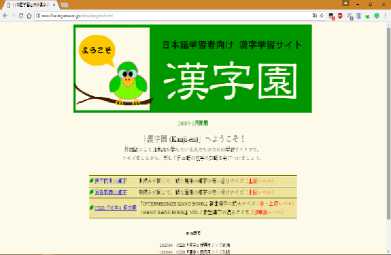
Fig.1. Kanji-en site which has three options that can be used.
As seen on the start page of the kanji-en site, there are 3 options that can be chosen by Japanese learners who want to practice Kanji. These options are marked with a blue underlined letter that can be selected. The first choice is 異
字同訓の漢字 iji doukun no kanji 'Kanji which has the same way of Kun-yomi reading but different form.' The second option is 同音異義の漢字douon igi no kanji 'Kanji that has the same way of On-yomi reading but different meaning'. The third option is CIER 「漢字」授業用 CIER "Kanji" jugyou-you 'CIER-Kanji used in lectures'. This Kanji-en site has experienced several updates as can be seen at the bottom of the site. The latest update is April 2015.
For learners who want to increase Kanji's mastery, they can choose the third option. A third option is to load exercises of the primary textbooks used in the Hyouki course in Japanese Literature Study Program, Faculty of Arts, Udayana University. The main textbook in question is used in the 2nd semester, namely Basic Kanji vol.2; used in the 3rd semester, namely Intermediate Kanji vol.1; and that is used in semester 4, namely Intermediate Kanji vol.2. The letters "L" on each page of the exercise indicate the lesson/chapter of the main textbook. In other words, the letter "L" is an abbreviation of the word lesson 'lesson' which is in accordance with the number of lesson that can be found in the main textbook. Kanji On-yomi training aims to train learners in the aspect of how to read kanjiin its on-yomiwhen those kanji characters are combined. The learner
will have to write in hiragana letters, the exact kanji combination reading in the empty box provided in each question. After completing the entire box learner can check their answers to these questions so that the learner can match the reply with the correct answer by pressing the "Check" button located under the last question of each exercises. The results of those works can be printed to
create a portfolio in order to see the learner's development.
!∙!⅛-⅛ - π X
I ml ιrts>sruns, i Ib⅛i w ∏L, l"l
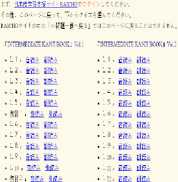
Fig. 2.Inside the option number 3 in the Kanji-en site where learners could choose among many exercises available accordingly to the textbook that is used.
-
IV. CONCLUSION
The analysis of the graph of the students’ Kanji Ability Mastery shows that on average the ability of the students of class 2014 both at the beginning of the survey and at the end of the survey is in the middle to upper level (scale of 2 to 4). There is an increase in the value scale of the survey results in 3 (25%) aspects of Kanji mastery. Meanwhile, the analysis of the graph of changes in Kanji mastery of the students of class 2015 shows that on average the ability of the students of class 2015 at the end of the survey is in the middle to upper level (scale of 2 to 5). There is an increase in the value scale of survey results on 7 (58%) aspects of Kanji mastery. This shows that there is relevance on giving Kanji lesson in semester 4, namely Hyouki course to increase the average ability of Kanjimastery aspects of the Japanese Literature Study Program students class 2015.
ACKNOWLEDGMENT
Author thanks Udayana University especially the Research and Community Service for the funding of this research and also for the active participation from the Japanese Literature Study Program students’ class 2014 and 2015 as the subject of this research.
REFERENCES
-
[1] Djajasudarma, T.Fatimah. 1993. Metode Linguistik: Ancangan Metode Penelitian dan Kajian. Bandung: Eresco.
-
[2] Kano, Chieko, dkk. 1993. Intermediate Kanji Book vol.1. Tokyo: Bonjinsha.
-
[3] Kida, Mari, dkk. 2011. Moji-Goi wo Oshieru. Tokyo: The Japan Foundation.
-
[4] Sakade, Florence dan Janet Ikeda. 2013. A Guide to Reading and Writing Japanese. Hongkong: Tuttle Publishing.
-
[5] Takagi, Hiroko. 2013. “Mieru Kanji Mondai to Mienai Kanji Mondai –Nihongo Kyouin Yousei no Tachiba kara Kangaeru, Nihongo Kyoushi to shite no Kanji no Atsukai to Sono Mondaiten–”. Jurnal Nihongo, vol.5, no.1. hal.1-8.
-
[6] Visiaty, Arianty & Vera Yulianti. 2012. Strategi Pemelajaran Kanji pada Pembelajar Non Kanji: Studi Kasus Mahasiswa Bahasa Jepang Tingkat Pemula di Jakarta. Prosiding Seminar Internasional Pendidikan Bahasa Jepang, hal.531-535 “Improving the
Competence of Conversation Skill in Learning Japanese Language in Secondary and Higher
Education in Indonesia”. Denpasar.
Discussion and feedback